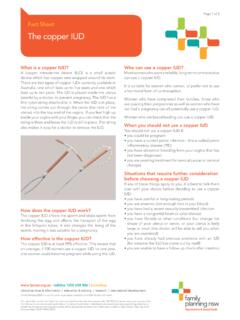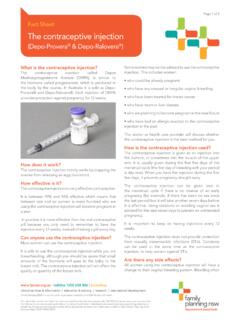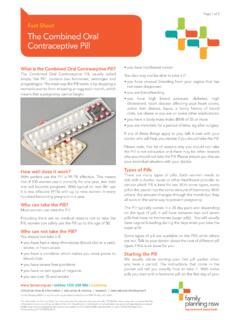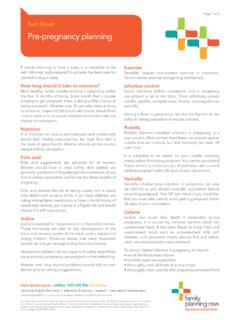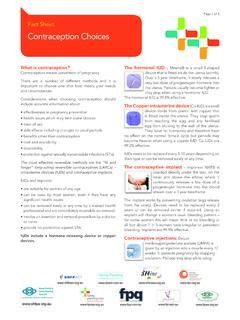Transcription of Fact Sheet The hormone-releasing IUD (Mirena
1 Page 1 of 3. Fact Sheet The hormone-releasing IUD. (Mirena ). What is the hormone-releasing IUD? one year, it is possible that one of them could become The only hormone-releasing intrauterine device (IUD) pregnant. available in Australia is called Mirena . It is a small plastic device in the shape of a T' with a hormone called Who can use the hormone-releasing IUD? levonorgestrel in its stem. It is placed inside the uterus Most women who want a reliable, long term contraceptive (womb) to prevent pregnancy. The IUD has a fine nylon can use it. string attached to it. When the IUD is in place, the string Women who have completed their families, those who comes out through the cervix (the neck of the uterus) into are spacing their pregnancies as well as women who have the top end of the vagina.
2 If you feel high up inside your not had a pregnancy can all potentially use a hormone- vagina with your finger, you can check that the string is releasing IUD. there and know the IUD is still in place. The string also makes it easy for a doctor to remove the IUD. Women who are breastfeeding can use a hormone- releasing IUD. The hormone-releasing IUD can stay in place for up to five years. It reduces menstrual bleeding which helps women who have heavy periods. Who should not use this type of IUD? You should not use a hormone-releasing IUD if: you could be pregnant you have a current pelvic infection - this is called pelvic inflammatory disease (PID). you have abnormal bleeding from your vagina, that has not been diagnosed you are waiting for treatment for cervical cancer or cervical changes Situations that require further consideration before choosing an IUD.
3 If any of these apply to you, you will need to talk them How does the hormone-releasing IUD work? over with your doctor before deciding to use a hormone- The hormone makes the mucus in the cervix thicker so releasing IUD: that sperm cannot get into the uterus. It also affects you have had a recent sexually transmitted infection (STI). the ability of the sperm and egg to move through the you have a congenital heart or valve disease uterus and fallopian tubes, which reduces the chance of you have fibroids or other conditions that change the an egg being fertilised. It also changes the lining of the shape of your uterus or cervix; or your uterus is fairly uterus, making it less suitable for a pregnancy.
4 It can also large or small (the doctor will be able to tell you when sometimes stop your ovaries from releasing an egg. you are examined). you have already had previous problems with an IUD. How effective is the hormone-releasing IUD? (for instance the IUD has come out by itself). The hormone-releasing IUD is at least 99% effective. This you are unable to have a follow-up check after insertion means that on average, if 100 women use an IUD for | talkline 1300 658 886 | bookshop clinical services & information | education & training | research | international development Family Planning NSW is a not-for-profit organisation funded by the NSW Ministry of Health The information in this Fact Sheet has been provided for educational purposes only.
5 FNPNSW has taken every care to ensure that the information is accurate and up-to-date at the time of publication. Individuals concerned about any personal reproductive or sexual health issue are encouraged to seek advice and assistance from their health care provider or visit a Family Planning Clinic. Reviewed May 2013/FPNSW 05/13. Page 2 of 3. Benefits with using a hormone-releasing IUD Occasionally a woman becomes pregnant with an IUD. It is a very effective form of contraception in place. This happens in fewer than one in 100 women It is long acting and can stay in place and protect who have an IUD. The IUD is usually removed although against pregnancy for up to five years this is associated with a small chance of miscarriage The hormone-releasing IUD called Mirena is listed If you fall pregnant with an IUD in place there is a on the PBS, which means that if you have a Medicare small risk that the pregnancy is outside the uterus card it is subsidised by the government.
6 If you have in the fallopian tubes. This is called an ectopic a Healthcare card you just pay the standard fee for a pregnancy. This is an uncommon complication and script at the pharmacy. If you don't have Medicare, the less common than amongst women who are not using initial cost of a hormone-releasing IUD is more than for any contraception other methods, but it lasts for five years so it can work out to be quite inexpensive How do you get the hormone-releasing IUD? It is immediately reversible so when it is removed you You need to go to a specially trained doctor for an IUD. return to your usual level of fertility At a Family Planning clinic you are usually asked to For women who have heavy periods, the hormone- make two visits.
7 On the first visit the doctor will ask you releasing IUD can be a very good choice as it usually questions about your general and reproductive health. makes bleeding much lighter and sometimes stops You will need to have a vaginal/pelvic examination, and if periods all together necessary a Pap test and possibly a test for infections. You will probably also be given a script to get the hormone- Possible problems with using a hormone- releasing IUD from a pharmacy before your insertion visit. releasing IUD. On the second visit you will have the IUD inserted. You I f you haven't had children or if you have only had may be given a local anaesthetic into the cervix before the caesarean deliveries, the IUD may be more difficult to IUD is inserted, but this is not always needed.
8 Sometimes insert women are referred to have the IUD inserted with some W omen may have irregular bleeding and spotting in intravenous sedation, especially if they are very anxious the first few months after the hormone-releasing IUD. or have not had a vaginal birth. is inserted. bleeding usually settles down and periods become shorter and lighter. Up to 65% of women end Your doctor will explain the procedure to you. It takes up with no bleeding at all after 12 months of use about 10 minutes and some women may find the S ome women may experience hormonal side effects, experience uncomfortable while others may find it quite such as bloating or skin changes, but this is uncommon painful.
9 You do not have to fast before the procedure, in because the dose of hormone is so small fact it is a good idea to eat before hand. You may feel T here is a small chance of getting a pelvic infection faint during or after the insertion and you will probably (PID) at the time of the IUD insertion. It occurs in about need to rest for a while before you leave the clinic. You one in every 500 insertions and usually happens in should allow about an hour to be at the clinic. the first 3 weeks after insertion. PID may rarely lead to reduced fertility and problems falling pregnant in What to expect after an IUD insertion some women You may have period-like cramps and bleeding or V ery rarely the wall of the uterus can be damaged by spotting in the first few days after the IUD is inserted.
10 The process of inserting an IUD, or by the IUD itself, Taking paracetamol and holding a hot water bottle on usually at the time of the insertion. It occurs in about your abdomen may help to relieve any discomfort. If one in every thousand insertions, although the risk cramps, spotting or pain last more than a few days, see of this may be slightly increased in women who are your doctor. You should avoid vaginal sex, tampons, breastfeeding, who have given birth in the past 6 swimming and baths for two days, to reduce the risk of months, or had a previous caesarean section infection. T he IUD may be pushed out of the uterus into the You will need to go back to the doctor for a check-up, vagina and can occasionally fall out, without you four to six weeks after the IUD insertion.
